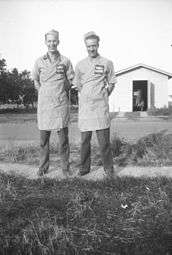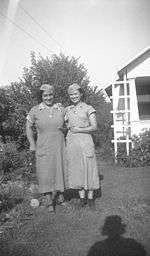Norton Simon
| Norton Simon | |
|---|---|
| Born |
Norton Simon 5 February 1907 Portland, Oregon, US |
| Died |
2 June 1993 Beverly Hills, California, US |
| Cause of death | Guillain–Barré syndrome |
| Residence | Beverly Hills, California |
| Citizenship | American |
| Alma mater | University of California, Berkeley |
| Occupation | Industrialist, philanthropist |
| Known for |
Founder of the eponymous Norton Simon Museum, Founder of Hunt's Foods |
| Home town | Fullerton, California |
| Political party | Republican |
| Board member of | Hunt's Foods |
| Religion | Judaism |
| Spouse(s) |
Lucille Ellis (?-1970; divorced) Jennifer Jones (1971-1993; his death) |
| Children |
Robert Simon (deceased) Donald Ellis Simon (1936-present) |
Norton Winfred Simon (February 5, 1907 – June 2, 1993), was an American millionaire industrialist and philanthropist based in California. His significant art collection is housed in the Norton Simon Museum in Pasadena, California.
Early life
Born into a successful Jewish family in Portland, Oregon, he attended high school in San Francisco, graduating in 1924. At his father's insistence, in 1925 he enrolled in the University of California, Berkeley, but left his pre-law studies within the first six weeks to found a sheet metal distribution company. He enjoyed early success and invested $7000 in 1927 in an orange juice bottling plant in Fullerton, California which was insolvent and renamed it Val Vita Food Products Company. He soon added other fruit and vegetables to the product lines and purchased canning equipment.
Business career
As one of the first of his significant corporate moves, Simon sold Val Vita to Hunt's Foods in return for a controlling interest in the combined business. By 1943 he changed the company's name to Hunt's Foods and ran it with strict cost-controls and an unorthodox approach to marketing. During and after World War II, Simon focused on product visibility. Uncharacteristically for a food company at the time, he acquired full page advertisements in Vogue and Life magazines with full-color photos of Hunt's ketchup bottles and tomato sauce cans. His aggressive advertising ensured the company's slogan "Hunt for the best" was prominent. His marketing strategy worked, and by 1945 Hunt Foods became a household name and one of the largest food processing businesses on the West Coast. Hunt's is now part of ConAgra Foods, Inc..
With the growing profits from Hunt Foods, he began buying stock in other undervalued companies with growth potential, many of which were still undervalued following the loss of confidence in equities after the Great Depression. He diversified through acquisition into well known businesses such as McCall's Publishing, the Saturday Review of Literature, Canada Dry Corporation, Max Factor cosmetics, the television production company Talent Associates, and Avis Car Rental, through his holding company Norton Simon Inc. (Norton Simon Inc. was formed in 1968 through the merger of Hunt Foods, McCalls Publishing and Canada Dry Corporation.) Many of these businesses had extensive interests outside the United States. Norton Simon Inc. was later acquired by Esmark in 1983, which merged with Beatrice Foods the next year. Beatrice was sold to ConAgra in 1990.
Art collection
Simon accumulated a significant private art collection which included works of the Impressionists, Old Masters, modern and native art. In the 1960s, he spent $4 million on artworks – an inventory of slightly less than 800 objects – and real estate – a building at 18 East 79th Street – from the Duveen Gallery in Manhattan, which specialized in old masters.[1][2] Scholars including the critic Clement Greenberg and the Metropolitan Museum of Art curator Theodore Rousseau studied the Duveen purchases for Simon and were able to identify numerous misattributions.[3] Simon ended up selling much of the collection[4] and only kept around 130 objects, primarily paintings, a handful of sculpture, a few porcelains, and a cape purportedly worn by Charles IV of Spain.[5] However, his collection holds three autograph Rembrandt paintings, considered highly important works of Rembrandt in Southern California.
Simon served as a trustee of the Los Angeles County Museum of History, Science and Art and supported the development of the LA County Museum of Art. Simon initially lent most of his art collection to that Museum although as it expanded he pioneered the "museum without walls" concept by actively lending his collection to different museums around the world.
In 1972, Simon bought a tenth-century South Indian bronze Nataraja, or dancing Shiva, from New York dealer Ben Heller for $900,000. The Indian government declared that the statue had been stolen from a temple in Tamil Nadu and smuggled abroad. Although Simon was quoted (New York Times, 12 May 1973) as saying that he had knowingly bought smuggled art (“Hell yes, it was smuggled. I spent between $15 and $16 million in the last two years on Asian art, and most of it was smuggled”) he vehemently denied the quote (Los Angeles Times, 13 May 1973), declaring that the work had been legally imported into the United States. In the same Los Angeles Times article, he stated, “As a collector deeply and emotionally involved in art, I deplore the rape of art treasures of any country.” In 1976 Simon reached an amicable agreement with the Union of India whereby he agreed to return the Nataraja to India. In exchange, the Indian government agreed that Simon could keep and display the bronze in his museum for nine years before its return.
Seeking a permanent home for his collection of over 4,000 objects, in 1972 he welcomed an overture from the financially troubled Pasadena Museum of Modern Art. He ultimately assumed control and naming rights, and in 1974 it was renamed the Norton Simon Museum. In 1987, the University of California, Los Angeles, announced an "agreement in principle" with Simon for the transfer to the university of the art collection owned by two Simon foundations – the Norton Simon Foundation and the Norton Simon Art Foundation.[6] The plan was to keep most of collection in Pasadena, administered by UCLA, the Simon board and the Norton Simon Foundation. The university was to build a separate museum facility on campus for part of the collection.[7] However, Simon withdrew his offer three months after the announcement was made.[8]
Later life
In 1969, his son Robert Simon committed suicide. The following year, he and his wife Lucille Ellis were divorced. He married actress Jennifer Jones in 1971. He also retired from active involvement in his business in 1969. He accepted appointments to the University of California Board of Regents, the Carnegie Commission on the Future of Higher Education, the boards of Reed College, the Los Angeles Music Center, the California School of Professional Psychology at Alliant International University, and the Institute for Advanced Study.
In 1970, Simon opposed U.S. Senator George Murphy's bid for a second term in the Republican primary. Murphy won renomination rather handily but then lost the seat in the general election to the Democrat John V. Tunney, even as Republican and future President Ronald Reagan was winning a second term as governor.
Death
He was diagnosed in 1984 with the neurological disorder Guillain–Barré syndrome, although he remained active in the Norton Simon Museum until his death.
References
- ↑ Eve M. Kahn (October 16, 2014), Behind the Scenes at Museums in Boston and Pasadena New York Times.
- ↑ Lock, Stock and Barrel: Norton Simon’s Purchase of Duveen Brothers Gallery, October 24, 2014 - April 27, 2015 Norton Simon Museum, Pasadena.
- ↑ Eve M. Kahn (October 16, 2014), Behind the Scenes at Museums in Boston and Pasadena New York Times.
- ↑ Eve M. Kahn (October 16, 2014), Behind the Scenes at Museums in Boston and Pasadena New York Times.
- ↑ Lock, Stock and Barrel: Norton Simon’s Purchase of Duveen Brothers Gallery, October 24, 2014 - April 27, 2015 Norton Simon Museum, Pasadena.
- ↑ Grace Glueck (February 21, 1987), Norton Simon's Art Is Slated For U.C.L.A. New York Times.
- ↑ William Wilson and Suzanne Muchnic (February 20, 1987), Simon UCLA Art Gift a Record: His $750-Million Collection Hailed as 'Stupendous' Los Angeles Times.
- ↑ Suzanne Muchnic (June 24, 1990), Simon Finally Breaks the Silence Los Angeles Times.
External links
- Hunt's Foods
- Norton Simon Museum
- Forbes Article on Norton Simon's Art Collection
- New Yorker Magazine article about Asian Art collecting in the US and Norton Simon's collection

